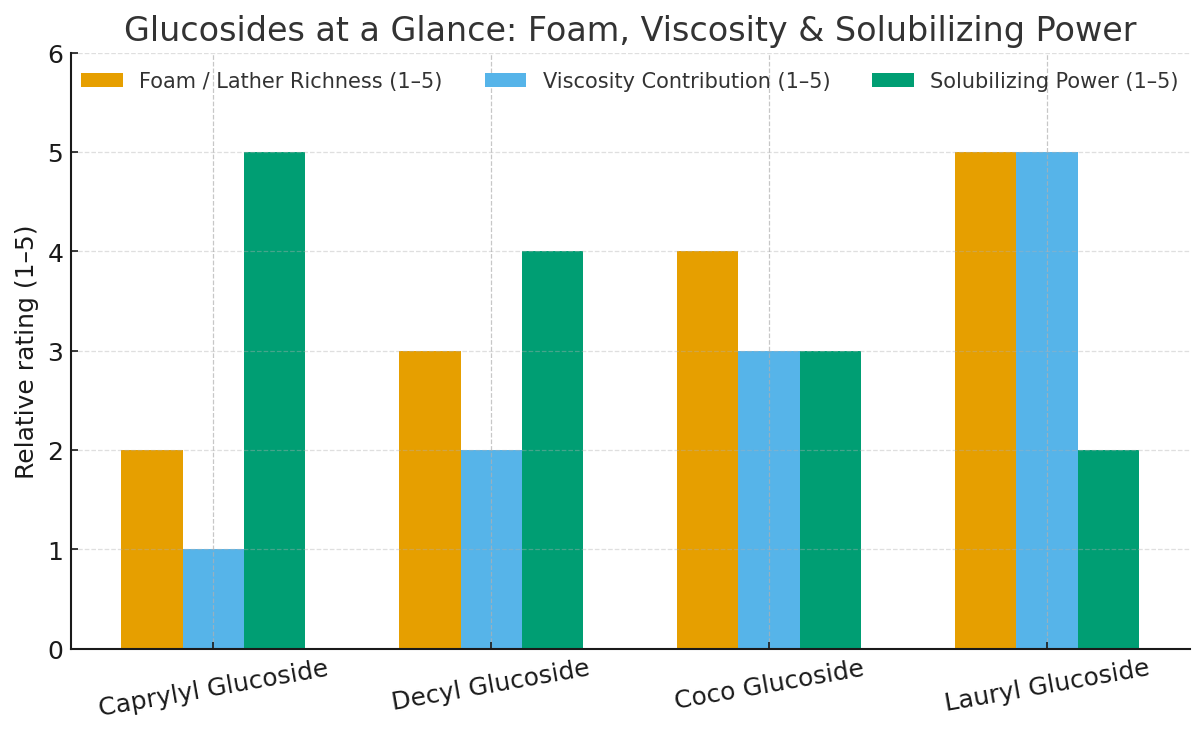
Surfactants 101: What They Are, Why Glucosides Are Special
If you make shampoos, face washes, or gentle pet cleansers, you live in surfactant land. This guide explains what surfactants are, what glucosides are, and how to choose among decyl, coco, caprylyl (often written capryl/caprylyl), and lauryl glucoside for different applications.
A) What are surfactants?
Surfactants (surface-active agents) are molecules with two “moods” in one body:
a lipophilic (oil-loving) tail and
a hydrophilic (water-loving) head.
This split personality lets them gather into tiny spheres called micelles that lift oily soil from skin or hair so water can rinse it away. Beyond cleaning, surfactants also:
Reduce surface tension (help water spread and wet surfaces),
Create foam (mostly aesthetics, but foam helps distribute product),
Emulsify (keep oil and water mixed),
Solubilize (help tiny amounts of oils/fragrances dissolve in water).
Surfactants come in four families: anionic (cleansing, more de-greasing), nonionic (mild, versatile), amphoteric/zwitterionic (very mild, foam boosters), and cationic (conditioning/antistatic).
Glucosides are nonionic—that’s a big reason they’re loved in “gentle” formulas.
B) What are glucosides?
Alkyl polyglucosides (APGs)—the family that includes decyl, coco, caprylyl, and lauryl glucoside—are made by joining glucose (sugar) to a fatty alcohol (often coconut- or palm-derived). Key perks:
Very mild to skin/scalp (and pet skin), low eye sting relative to many anionics.
Plant-derived and readily biodegradable, often approved by natural/eco standards.
Electrolyte tolerant and generally pH-flexible (you’ll still adjust final pH).
C) Decyl vs. Coco vs. Caprylyl vs. Lauryl Glucoside
Think of each glucoside’s alkyl chain length as a “dial” that tunes behavior: shorter = better solubilizer/thinner; longer = richer foam/thicker.
|
Glucoside |
Feel & Foam |
Thickening Behavior |
Solubilizing Power |
Where It Shines |
|
Caprylyl (Capryl/Caprylyl) Glucoside |
Gentle, light foam |
Very thin; can reduce viscosity |
Excellent (great at dissolving fragrance/EOs) |
Micellar waters, makeup removers, spray cleansers, all-purpose cleaners, baby/pet at low % |
|
Decyl Glucoside |
Mild, dense creamy foam |
Thin on its own; thickens with salt/gums/CAPB |
Very good |
Face/body wash, baby shampoos, pet shampoos, natural dish/hand soaps |
|
Coco Glucoside |
Creamy foam, good cleansing |
Helps build viscosity more than decyl |
Good |
Body wash & shampoo bases, general household cleaners, fragrance solubilizing assist |
|
Lauryl Glucoside |
Richest, creamiest foam of the four |
Best natural thickener; can go gel-like |
Fair |
Shampoos/body washes that need body, sulfate-free “luxury foam,” scrubs |
Takeaway
All four glucosides are gentle, plant-derived, and biodegradable. Combine with an amphoteric like CAPB and fine-tune salt and pH to get the exact feel you want—whether that’s a plush sulfate-free shampoo, a soft pet wash, or a minimalist micellar water.
